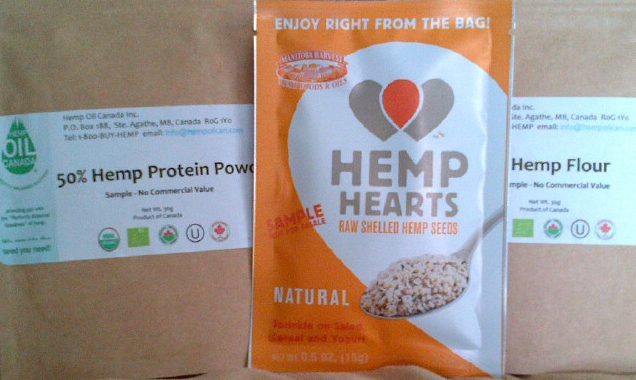
All About Hemp
Often I receive new food, beverage and ingredient samples from suppliers to taste test or use in recipes. It is one of the interesting perks of being a Dietitian! Over the past six months, I’ve sampled avocado oils, ready to brew cocoa and hemp seeds, powder and flours. Hemp as a food is still a mystery to many, so I decided to create this Grow with Nutrition post All About Hemp.
Let’s start by understanding the difference between marijuana and hemp. Both industrial hemp and marijuana have the same taxonomical classification of Cannabis sativa. However, hemp lacks much of the primary stimulating psychoactive ingredient in marijuana known as delta-9 tetrahydrocannabinol (THC). Hemp is bred to maximize the amount of fibre, seed and/or oil characteristics, whereas marijuana breeding aims to increase THC component (usually between 4 to 20%). Hemp is a stronger plant than marijuana which is actually quite delicate.
Hemp Production in Canada
- Hemp growers in Canada must obtain the appropriate licences from Health Canada, as it is strictly regulated because of its taxonomical classification – Cannabis sativa. Due to these origins, hemp planted in Canada must have less than 0.3% THC and only certified seeds are to be planted (Canadian Hemp Trade Alliance, 2012).
- Those who sell hemp seeds in Canada must include a Certified Seed Tag to the farmer which the farmer must be able to produce to inspectors at any time (Canadian Hemp Trade Alliance, 2012).
- In 2011, the three provinces with the greatest hemp seed acreage were Alberta, Saskatchewan and Manitoba producing 6434, 4026 and 4596 hectares respectively (Alberta Agriculture and Rural Development, 2012).
Four Fun Hemp Facts
- Washington State University produced hemp fiberboard which was twice as strong as wood-based fiberboard and required no additional resins due to naturally-occurring lignins (Hemp Industries Association, 2009).
- During the Colonial Era and Early Republic the American government made it mandatory for farmers to grow hemp and both President Washington and Jefferson grew hemp crops. As part of hemp subsidization program American farmers grew approximately one million acres of hemp during World War II (Hemp Industries Association, 2009).
- The Hemp seed is second only to soybeans as a complete protein and contains more essential fatty acids than any other source. It also a great source of fibre and B-vitamins (Hemp Industries Association, 2009).
- One ounce serving of hemp seeds provides 11 grams of complete protein (providing all the essential amino acids for the body).
Nutritional Benefits of Hemp Seeds and Oil
- Approximately 30% of hemp seed is composed of carbohydrates with the vast majority in the form of dietary fibre (1). As we know, dietary fibre is linked positively to many human health conditions. In addition to dietary fibre having the the ability to increase intestinal transit time supporting gut health, research has shown it may help decrease blood cholesterol promoting heart health. Including dietary fibre in your meal plan also helps increase satiety, the feeling of fullness, so you don’t overeat. Check out the protein benefits in Four Fun Hemp Facts in this post.
- Hemp oil has a unique concentration of polyunsaturated fatty acids (PUFAs) which is over 80% of the total composition (3). According to the World Health Organization, the ideal ratio of Omega 6 to Omega 3 is 4:1. Hemp oil has similar ratio of Omega 6 to Omega 3 of 3:1 which helps to support human health (3). Hemp oil is one of the few sources of a rare Omega 6 called gamma-linoleic acid (GLA). Research has shown that GLA may support heart health, weight management and decrease dry skin. In a randomized, cross-over control trial (3), the consumption of PUFAs from hemp oil showed a decreased in a skin condition known as atopic dermatitis.
To get more hemp into your meal plan, toss 2 tablespoons of the seeds into your oatmeal or stir-fry. Or add them to your post workout shake for extra protein.
References
- Callaway, J. C. Hempseed as a nutritional resource: An overview. Euphytica. 2004. 140:65-72.
- Dhingra, D., et al. Dietary fibre in foods: a review. Journal of Food Science and Technology. 2011. 49(3):255-266.
- Callaway, J. C., et al. Efficacy of dietary hempseed oil on plasma lipids and skin quality in patients with atopic dermatitis. Journal of Dermatitis Treatment. 2005. Apr;16(2):87-94.
